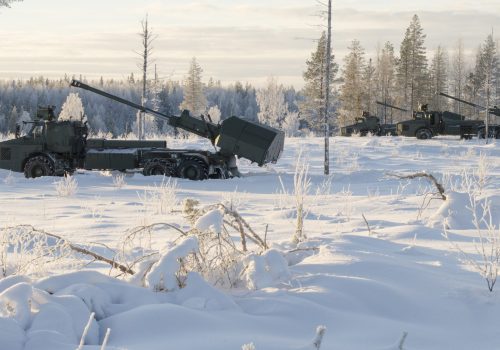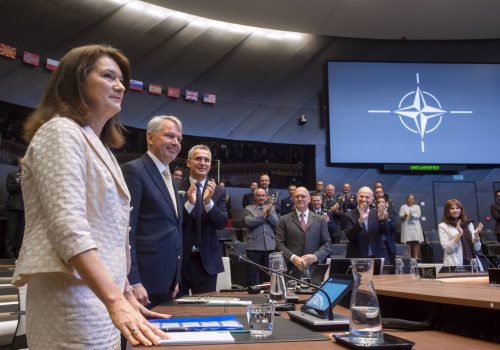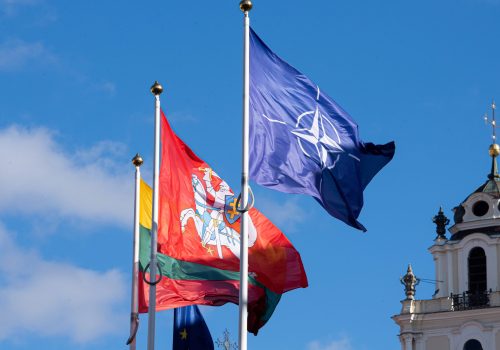On April 17, a battalion of seven hundred US soldiers rolled over the Swedish border from Norway, marking the start of the largest Swedish military exercise in more than twenty-five years. Aurora 2023 runs until May 11 and consists of more than 26,000 soldiers from fourteen countries. It practices a scenario in which Sweden is subject to influence operations and hybrid attacks that escalate into an armed conflict.
Aurora takes place across all domains and Swedish territory, but it has a particular focus on southern Sweden and the strategically important island of Gotland in the Baltic Sea. As Sweden is on the verge of joining NATO, Gotland illustrates Sweden’s key role as a security provider in the region. For the Alliance, the control of Gotland can make a decisive difference in the defense of Estonia, Latvia, Lithuania, Finland, and Poland.
Through Aurora 2023, Sweden is not just practicing how to give and take military support during a war. It is also sending a strong political signal about its importance to NATO, a signal amplified by US Secretary of Defense Lloyd J. Austin’s multi-day visit to Sweden during the first days of the exercise last week—the first by a Pentagon chief in more than twenty years.
Why is Gotland so central for collective defense? In the Baltic Sea region, with its short geographic distances, freedom of movement will be critical for operating in the area. In a range of war games that the United States and NATO conducted after the Russian annexation of Crimea in 2014 to prepare to defend the Baltics, Gotland played a central role. That centrality is further underlined by Russia’s ability to create a “bubble” of anti-access/area-denial capacity in the region via Kaliningrad. In order to strengthen its capacity to deny NATO access to airspace over the Baltic Sea, the Swedish government has assessed that Russia may be interested in deploying air-defense systems to Swedish territory, especially Gotland. Accordingly, a main attack against the Baltic States could be preceded by operations against Sweden.
Ben Hodges, then commanding general of US Army forces in Europe, described Gotland as a key location on his visit to the island in July 2017. Addressing the Swedish soldiers, he explained, “You have a strategically very important task here. I do not think there is any island anywhere that is more important.”
Roughly the size of Rhode Island and with a population of 58,000, Gotland was demilitarized in 2005, in an era after the Cold War marked by peace and cooperation in the Baltic Sea region. After Russia’s annexation of Crimea in 2014, the demilitarized status soon became a security challenge for Sweden. Therefore, Sweden’s armed forces decided to re-introduce permanent troops on the island in 2016. In 2018, a new regiment was established that includes four hundred permanently placed troops, a mechanized battalion with CV90 armored vehicles and Leopard 2 tanks, and a Home Guard amphibious battalion. In 2021, air defense systems were reactivated.
Russia’s full-scale invasion of Ukraine last year led to additional reinforcements, exercises, and investment in Gotland’s defense. As Russian troops massed along Ukraine’s border in January 2022, units were reallocated to Gotland overnight and CV90s were seen patrolling the streets of medieval Visby. Highlighting the strategic exposure of the island, four Russian jets buzzed Gotland’s airspace as the Swedish and Finnish defense ministers were observing a joint Swedish-Finnish exercise in March 2022. Then in April 2022, the government decided to invest 1.6 billion Swedish crowns (approximately $160 million) to strengthen military infrastructure on Gotland.
During the ongoing 2023 Aurora exercise, British and Polish amphibious units will train with Sweden on Gotland. The simultaneous Polish exercise Anakonda will also test Swedish air defenses. Sweden, in turn, will practice attacking targets along the Polish coast. With Russian exclave Kaliningrad only two hundred miles away, the ability to rapidly defend and respond to an armed Russian aerial assault on Gotland is key in securing the Baltic Sea. Even as far back as 2016, then US Deputy Secretary of Defense Robert Work stated during a visit to Sweden that “the US would take it very, very seriously if there were a threat against Gotland.”
The demonstration of Sweden’s military capability and interoperability with NATO allies comes as Sweden awaits ratification by Turkey and Hungary for its pending membership. To signal strong US support for Sweden’s membership, Austin decided to observe the Aurora exercise in person, as opposed to the originally planned visit after Sweden’s final ratification.
After taking a ride on a Visby-class corvette with Black Hawk helicopter and JAS Gripen flyovers, Austin praised the armed forces in a press conference with his Swedish counterpart, Pål Jonson. “As I’ve seen firsthand on this trip, the Swedish Armed Forces are an exceptionally capable and highly professional fighting force,” Austin said. “Sweden’s troops and capabilities will enhance NATO’s operations to deter conflict, including in the Baltic Sea region.” The secretary then called upon Turkey and Hungary “to ratify Sweden's accession as soon as possible,” anticipating that Sweden will be a member of NATO by the time of the Vilnius Summit in July.
Whether NATO’s ratification process will be complete by July remains uncertain. But what the ongoing Aurora 2023 exercise demonstrates is that Sweden’s military capabilities and geography make it a key security provider for the northeastern flank and for the Alliance as a whole.
Anna Wieslander is director for Northern Europe at the Atlantic Council and head of its Northern Europe office in Stockholm. She is a former official at the Swedish Defence Ministry and Swedish Parliament.
Eric Adamson is project manager at the Northern Europe Office.
Further reading
Fri, Jan 6, 2023
How allied Sweden and Finland can secure Northern Europe
Issue Brief By
NATO is approaching its ninth round of enlargement. The accession of Sweden and Finland—two solid democracies and defenders of the international-rules based order—into the Alliance will strengthen the core of the transatlantic community.
Mon, Aug 8, 2022
When will Sweden and Finland join NATO? Tracking the ratification process across the Alliance.
New Atlanticist By
With this tracker, the Atlantic Council team is keeping tabs on the countries that have ratified the amended NATO treaty—and handicapping the political prospects for ratification in the rest.
Tue, Apr 11, 2023
Defining success for NATO’s Vilnius summit: A primer
Issue Brief By
A successful NATO summit in July requires significant progress on a host of NATO’s political and military priorities, especially those enumerated at Madrid.
Image: Sweden's military personnel look on during the visit of US Defence Secretary Lloyd Austin to the Musko naval base, around 70 kilometers south of the capital, Stockholm, Sweden.



